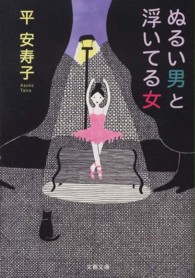- ホーム
- > 洋書
- > 英文書
- > History / World
Description
(Text)
This book examines patterns of national integration and the mobilisation of the peasantry across two historical regions, Central and Eastern Europe, over a long historical timeframe, spanning from the 1848 Revolution to the outbreak of the Second World War. It discusses how national elites in these regions interacted with the peasantry during the process of building modern nation-states and democratic political systems, and how political integration occurred by transforming peasants from subjects of various public actors into active citizens. The authors focus on the mechanisms employed by nation-states to achieve the socio-political integration of the peasantry, including land redistribution, universal suffrage, state-sponsored education, taxation, and military conscription, and on diverse channels of communicating the state s agenda of modernisation, such as the church, the press, political parties, and other types of intermediaries. This book promotes interdisciplinary andcomparative approaches to the question of the social and political integration of peasants within the various societies of the Austro-Hungarian Empire and the emerging nation-states of Central and Eastern Europe.
(Table of content)
1. Introduction: The Peasantry and Political Participation in Central and Eastern Europe, 1848-1939; Sorin Radu, Constantin Iordachi, Ovidiu Buruiana, Andrei Florin Sora.- 2. Reforming the Land and the Peasant after 1800: How to Make National Peasantries; Eric Vanhaute.- Part I. Under the Assault of Modernity: Rural Realities in Central and Eastern Europe - National, Imperial, and Post-imperial Models.- 3. Peasants' Migration, Social Mobility, and National Identity in a Post-Serfdom Society: Upper Silesia between the 1850s and 1930s; Andrzej Michalczyk.- 4. How Did Peasants Go to the Bank? An Introduction to the Educational Activities of the Peasants Land Bank in the Late Russian Empire; Arina Fedorova.- 5. Vote Masaryk! High Politics and a Reversal in a Semi-rural Town: The Case of Zlín in the Early Twentieth Century; Milan Repa.- 6. The Czech Agrarian Movement and the Challenge of Class: Integrating the 'Agricultural Estate' in the South Bohemian Countryside, 1918-1938; Lucian George.- 7. Having it Both Ways: Preserving an Idyllic Rural Universe and Overcoming Backwardness by the Right School-Education; Wilfried Göttlicher.- 8. The Peasant Sociology of Ferenc Erdei; Nigel Swain.- Part II. Mobilising the Peasants: National Apathy and Political Integration in National, Imperial, and Post-imperial Romania, 1830-1940.- 9. The Limits of Ethnic Power: Peasant Life in Transylvania, the Romanian Principalities and the Romanian Kingdom during the Long Nineteenth Century; Cornel Ban.- 10. Peasants into Romanians: The Trial of Satmar, 1914, and Ethnic Bifurcation in Dualist Hungary; Anders E. B. Blomqvist.- 11. "The Silent World": The Romanian State and the Political Integration of Peasants during the Interwar Period; Sorin Radu, Ovidiu Buruiana, Andrei Florin Sora.- 12. Degrees of Crisis: The Romanian Countryside during the Great Depression; Anca Mândru.- 13. Disability in the Interwar Romanian Village: Peasants, Teachers, Priests,and Miracles; Maria Bucur.- Part III. Conclusion. 14. Conclusion; Constantin Iordachi.








